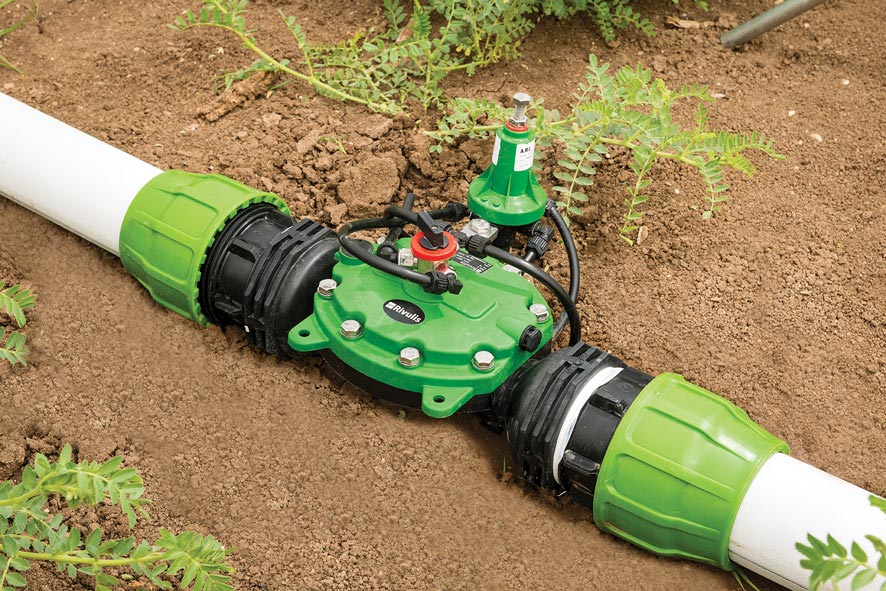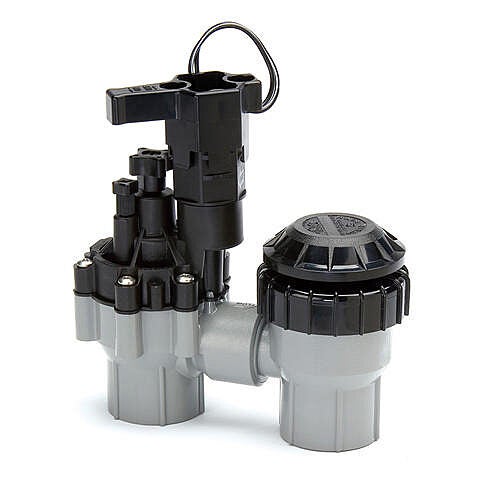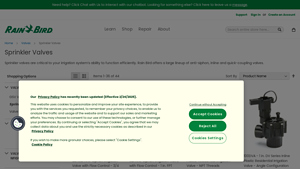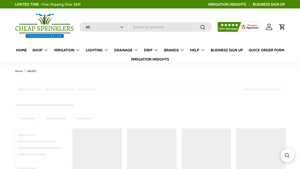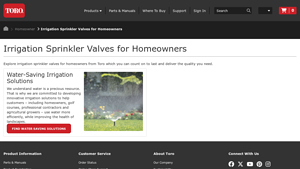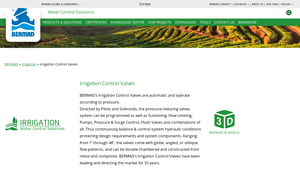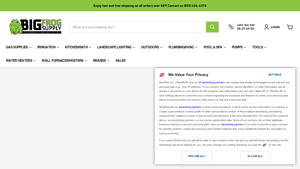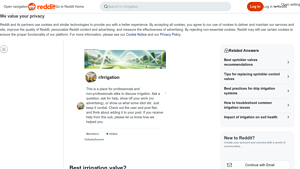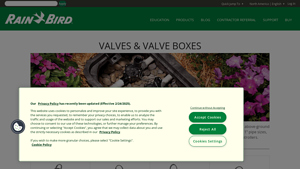Introduction: Navigating the Global Market for irrigation control valves
In the ever-evolving landscape of agriculture and landscaping, international B2B buyers face the critical challenge of sourcing high-quality irrigation control valves that ensure efficient water management and optimize resource utilization. Understanding the diverse types of valves, their specific applications, and the nuances of supplier vetting is essential for making informed purchasing decisions in a competitive global market. This guide comprehensively explores the various categories of irrigation control valves, including anti-siphon, inline, and quick-coupling options, along with their respective functionalities and benefits.
By delving into key factors such as cost analysis, performance specifications, and regional compliance standards, we aim to empower buyers from Africa, South America, the Middle East, and Europe—particularly those in Germany and Vietnam—to navigate the complexities of the irrigation industry with confidence. Whether you’re looking to enhance agricultural productivity or improve landscape aesthetics, understanding the intricacies of irrigation control valves is crucial for optimizing water management strategies and achieving sustainable outcomes. This resource serves as your essential toolkit for making strategic procurement decisions that align with your operational goals and environmental responsibilities.
Understanding irrigation control valves Types and Variations
| Type Name | Key Distinguishing Features | Primary B2B Applications | Brief Pros & Cons for Buyers |
|---|---|---|---|
| Anti-Siphon Valves | Prevent backflow, integrated pressure regulation | Residential and commercial irrigation | Pros: Prevents contamination, easy installation. Cons: May require more maintenance due to moving parts. |
| Inline Valves | Directly connected to the irrigation line, compact | Large-scale agriculture, industrial use | Pros: Space-efficient, versatile for various systems. Cons: Can be more complex to install. |
| Electric Control Valves | Automated operation via electric solenoids | Smart irrigation systems, commercial farms | Pros: Remote control capability, energy-efficient. Cons: Higher upfront cost, requires electrical setup. |
| Manual Control Valves | Operated manually, simple design | Small gardens, DIY applications | Pros: Low cost, straightforward operation. Cons: Labor-intensive, less efficient for large areas. |
| Pressure Regulating Valves | Maintains consistent water pressure | High-pressure systems, variable terrain | Pros: Protects system from pressure spikes, improves efficiency. Cons: More expensive than standard valves. |
What Are Anti-Siphon Valves and Their Key Benefits for B2B Buyers?
Anti-siphon valves are designed to prevent backflow, ensuring that contaminated water does not enter the main supply. These valves often come with built-in pressure regulation, making them suitable for both residential and commercial irrigation systems. When considering procurement, buyers should evaluate the ease of installation and maintenance requirements, as these valves can sometimes necessitate more frequent servicing due to their mechanical components. Their ability to safeguard water quality makes them particularly appealing for businesses focused on compliance with health regulations.
How Do Inline Valves Enhance Efficiency in Large-Scale Applications?
Inline valves are characterized by their direct connection to the irrigation line, allowing for a seamless integration into existing systems. This compact design is especially beneficial for large-scale agricultural and industrial applications, where space is at a premium. B2B buyers should consider the installation complexity and the adaptability of these valves for different irrigation configurations. Inline valves are often preferred for their versatility and ability to handle varying flow rates, making them an ideal choice for diverse agricultural needs.
Why Choose Electric Control Valves for Smart Irrigation Systems?
Electric control valves operate through solenoids, allowing for automated control of irrigation schedules. This feature is particularly advantageous for commercial farms and smart irrigation systems, where efficiency and precision are paramount. When purchasing electric control valves, buyers should weigh the upfront costs against long-term energy savings and labor reductions. The ability to integrate these valves with smart technology enhances their appeal, making them a valuable investment for businesses looking to optimize water usage.
What Advantages Do Manual Control Valves Offer for Small-Scale Irrigation?
Manual control valves are straightforward devices that require human intervention for operation. They are typically less expensive and easier to install, making them suitable for small gardens and DIY projects. However, B2B buyers should recognize that while these valves may save initial costs, they can be labor-intensive and less efficient for larger areas. Buyers should assess their specific irrigation needs and consider whether the simplicity of manual control aligns with their operational goals.
How Do Pressure Regulating Valves Contribute to System Longevity?
Pressure regulating valves are essential for maintaining a consistent water pressure within irrigation systems, particularly in high-pressure environments or variable terrain. By protecting the system from pressure spikes, these valves improve overall efficiency and can extend the lifespan of other irrigation components. B2B buyers should be prepared for a higher initial investment but should also consider the long-term benefits of reduced wear and tear on the system. Proper selection and installation can significantly enhance irrigation performance, making these valves a worthwhile consideration for serious agricultural operations.
Key Industrial Applications of irrigation control valves
| Industry/Sector | Specific Application of Irrigation Control Valves | Value/Benefit for the Business | Key Sourcing Considerations for this Application |
|---|---|---|---|
| Agriculture | Precision irrigation in crop production | Optimizes water usage, increases yield | Compatibility with existing systems, flow rate specifications, and durability against environmental factors. |
| Landscaping & Horticulture | Automated irrigation systems for parks and gardens | Enhances aesthetic value and reduces labor costs | Customization options, ease of installation, and maintenance requirements. |
| Industrial Facilities | Water management in manufacturing processes | Reduces operational costs and waste | Material quality for chemical resistance, pressure ratings, and automation compatibility. |
| Municipal Water Supply | Control of public irrigation systems | Ensures sustainable water distribution | Compliance with local regulations, flow control capabilities, and reliability under varying pressure conditions. |
| Sports Facilities | Irrigation for sports fields and golf courses | Maintains turf quality and reduces downtime | Efficiency in water distribution, resistance to wear and tear, and ease of integration with existing systems. |
How Are Irrigation Control Valves Used in Agriculture?
In the agriculture sector, irrigation control valves are vital for implementing precision irrigation systems. These valves enable farmers to regulate water flow to various crop zones, ensuring optimal moisture levels tailored to specific crop needs. This targeted approach not only conserves water but also enhances crop yields. International buyers must consider compatibility with existing irrigation infrastructure, the ability to handle varying flow rates, and the durability of materials against environmental stressors, particularly in regions with extreme weather conditions.
What Role Do Irrigation Control Valves Play in Landscaping and Horticulture?
In landscaping and horticulture, irrigation control valves are essential for automating watering systems in parks, gardens, and commercial landscapes. These valves facilitate efficient water distribution, ensuring that plants receive the right amount of moisture without waste. This automation reduces labor costs and improves the overall aesthetic value of green spaces. Buyers should prioritize customization options, ease of installation, and ongoing maintenance requirements to ensure long-term functionality in diverse climates.
How Are Irrigation Control Valves Utilized in Industrial Facilities?
Irrigation control valves find significant applications in industrial facilities, particularly for water management in manufacturing processes. These valves help regulate water supply for cooling systems, cleaning processes, and even landscape maintenance within industrial sites. By optimizing water use, businesses can significantly reduce operational costs and minimize waste. When sourcing for industrial applications, considerations should include material quality for chemical resistance, appropriate pressure ratings, and compatibility with automation systems to enhance operational efficiency.
Why Are Irrigation Control Valves Important for Municipal Water Supply?
Municipal water supply systems utilize irrigation control valves to manage public irrigation effectively. These valves play a crucial role in ensuring sustainable water distribution across parks, sports fields, and other public spaces. By regulating flow and pressure, municipalities can maintain green areas while conserving water resources. Buyers in this sector need to ensure that valves comply with local regulations, possess adequate flow control capabilities, and are reliable under varying pressure conditions to ensure public safety and sustainability.
What Benefits Do Irrigation Control Valves Offer for Sports Facilities?
In sports facilities, irrigation control valves are integral for maintaining the quality of turf on fields and golf courses. These valves enable precise irrigation, ensuring that grass remains healthy and playable, which minimizes downtime for maintenance. Effective water management helps prevent over-saturation and promotes optimal growth conditions. Sourcing considerations for sports facilities should include efficiency in water distribution, resistance to wear and tear from heavy foot traffic, and ease of integration with existing irrigation systems to facilitate seamless operations.
3 Common User Pain Points for ‘irrigation control valves’ & Their Solutions
Scenario 1: Difficulty in Ensuring Consistent Water Pressure Across Zones
The Problem: Many B2B buyers managing large agricultural or landscaping projects struggle with maintaining consistent water pressure across multiple irrigation zones. Inconsistent pressure can lead to uneven watering, resulting in over-saturation in some areas and drought in others. This not only affects plant health but can also lead to increased operational costs due to wasted water and energy. Buyers often find it challenging to assess the appropriate valve specifications that can adapt to varying pressure requirements.
The Solution: To overcome this challenge, buyers should invest in pressure-regulating irrigation control valves. These valves are designed to maintain a consistent pressure level throughout the irrigation system, regardless of fluctuations in the main water supply. When sourcing these valves, it’s crucial to analyze the specific pressure requirements of each zone. Look for valves with adjustable settings that allow for customization based on the unique needs of different plant types or soil conditions. Collaborating with reputable suppliers who offer a wide range of products can help buyers find the right fit. Additionally, regular maintenance checks should be implemented to ensure valves are functioning correctly and to make adjustments as necessary.
Scenario 2: Frequent Valve Failures Due to Environmental Conditions
The Problem: In regions with extreme weather conditions—such as high temperatures, heavy rainfall, or saline environments—irrigation control valves can fail frequently, leading to costly downtime and repairs. Buyers in these areas often report that conventional valves do not withstand harsh conditions, resulting in leaks or complete breakdowns that disrupt irrigation schedules.
The Solution: To mitigate this issue, it is essential for buyers to select valves specifically designed for resilience in challenging environments. Opting for UV-resistant materials and corrosion-proof designs can significantly enhance the lifespan of irrigation valves. Buyers should prioritize suppliers who offer products tested for durability under specific environmental conditions. Implementing a preventive maintenance program can also help identify early signs of wear and tear, allowing for timely replacements before failures occur. Furthermore, considering the installation of additional protective measures—such as valve boxes or covers—can shield valves from direct exposure to extreme elements.
Scenario 3: Complications in Automation and Smart Irrigation Integration
The Problem: As the industry moves towards smart irrigation systems, many B2B buyers face challenges integrating traditional irrigation control valves with automated systems. Buyers often find themselves grappling with compatibility issues, leading to inefficient water usage and difficulties in managing irrigation schedules remotely. This situation can result in wasted resources and increased labor costs, as manual adjustments become necessary.
The Solution: To address integration challenges, buyers should seek out irrigation control valves that are compatible with smart technology and automation systems. Conducting thorough research on the specifications of both the valves and the automation technology is crucial. It’s advisable to partner with manufacturers that provide clear documentation and support for integration processes. Additionally, investing in smart controllers that offer real-time monitoring and data analytics can enhance decision-making regarding irrigation schedules and water usage. Training staff on the operation and troubleshooting of these systems can further streamline processes and ensure effective management of resources.
Strategic Material Selection Guide for irrigation control valves
What Are the Key Materials Used in Irrigation Control Valves?
When selecting irrigation control valves, the choice of material significantly impacts performance, durability, and compatibility with various irrigation systems. Here, we analyze four common materials used in the manufacturing of these valves: plastic, brass, stainless steel, and bronze.
How Does Plastic Perform in Irrigation Control Valves?
Plastic is widely used in irrigation control valves due to its lightweight nature and resistance to corrosion. Common types of plastic include PVC and polypropylene, which can typically handle pressures up to 150 psi and temperatures ranging from 32°F to 120°F.
Pros:
– Cost-effective and lightweight, making transportation easier.
– Excellent corrosion resistance, ideal for chemical applications.
– Easy to install and maintain due to its low weight.
Cons:
– Limited temperature and pressure ratings compared to metal options.
– Susceptible to UV degradation if not treated, which can shorten lifespan.
Impact on Application:
Plastic valves are suitable for low-pressure applications and environments where corrosion is a concern. However, they may not be ideal for high-pressure systems or extreme temperature applications.
Considerations for International Buyers:
Buyers should ensure compliance with local standards, such as ASTM or ISO specifications, especially in regions with strict regulations. In Africa and South America, where UV exposure is high, selecting UV-resistant plastics is crucial.
What Advantages Does Brass Offer for Irrigation Control Valves?
Brass is another popular material for irrigation control valves, known for its strength and durability. It can withstand high pressures (up to 300 psi) and operates effectively in a wide temperature range.
Pros:
– High durability and resistance to wear and tear.
– Excellent thermal conductivity, which can be beneficial in temperature regulation.
– Resistant to corrosion, especially in freshwater applications.
Cons:
– Higher initial cost compared to plastic.
– Heavier, which can increase shipping costs and installation complexity.
Impact on Application:
Brass valves are well-suited for high-pressure applications and environments where durability is paramount. Their robustness makes them ideal for commercial agricultural applications.
Considerations for International Buyers:
Brass valves must comply with relevant standards like ASTM B16.18 or DIN 50930-6. In Europe, buyers should consider lead-free options due to stringent regulations regarding drinking water safety.
How Does Stainless Steel Compare for Irrigation Control Valves?
Stainless steel is renowned for its exceptional strength and resistance to corrosion, particularly in harsh environments. It can handle high pressures (up to 500 psi) and extreme temperatures, making it suitable for various applications.
Pros:
– Outstanding corrosion resistance, even in saline or acidic environments.
– Long lifespan due to high durability.
– Aesthetic appeal for visible installations.
Cons:
– Higher cost compared to brass and plastic.
– Requires specialized fittings for installation, which can complicate logistics.
Impact on Application:
Stainless steel valves are ideal for industrial irrigation systems and applications involving aggressive media. Their durability ensures reliable performance over time.
Considerations for International Buyers:
Buyers should be aware of compliance with standards such as ASTM A312 or JIS G3459. In regions with high salinity, stainless steel valves offer a significant advantage.
What Role Does Bronze Play in Irrigation Control Valves?
Bronze is often used for its excellent corrosion resistance and strength, particularly in marine environments. It can handle pressures up to 200 psi and operates effectively in a broad temperature range.
Pros:
– Good resistance to corrosion, especially in seawater.
– Durable and strong, suitable for heavy-duty applications.
– Less expensive than stainless steel while offering similar benefits.
Cons:
– Heavier than plastic, which can increase shipping costs.
– May require more maintenance compared to stainless steel.
Impact on Application:
Bronze valves are particularly suitable for applications near coastal areas or in systems that utilize reclaimed water.
Considerations for International Buyers:
Compliance with standards such as ASTM B584 is essential. Buyers in the Middle East and coastal regions should prioritize bronze for its corrosion resistance.
Summary of Material Selection for Irrigation Control Valves
| Material | Typical Use Case for irrigation control valves | Key Advantage | Key Disadvantage/Limitation | Relative Cost (Low/Med/High) |
|---|---|---|---|---|
| Plastic | Low-pressure irrigation systems | Cost-effective and lightweight | Limited temperature/pressure rating | Low |
| Brass | High-pressure agricultural applications | High durability | Higher initial cost | Medium |
| Stainless Steel | Industrial and aggressive media applications | Outstanding corrosion resistance | Higher cost and installation complexity | High |
| Bronze | Marine and reclaimed water applications | Good corrosion resistance | Heavier and requires maintenance | Medium |
This strategic material selection guide provides valuable insights for international B2B buyers, enabling them to make informed decisions based on the specific needs of their irrigation systems.
In-depth Look: Manufacturing Processes and Quality Assurance for irrigation control valves
What Are the Key Stages in the Manufacturing Process of Irrigation Control Valves?
The manufacturing of irrigation control valves involves several crucial stages, each designed to ensure that the final product meets rigorous performance and quality standards.
Material Preparation
The first stage in manufacturing involves the careful selection and preparation of raw materials. Common materials for irrigation control valves include brass, plastic, and stainless steel. The choice of material impacts durability, resistance to corrosion, and overall performance in various environmental conditions. Manufacturers often source materials that comply with international standards, such as ASTM or ISO specifications. Once the materials are selected, they are cut, shaped, and treated as necessary to achieve the desired properties.
Forming Techniques: How Are Irrigation Control Valves Shaped?
The forming stage is where raw materials are transformed into valve components through various techniques. Common methods include:
- Injection Molding: Predominantly used for plastic valves, this method involves injecting molten plastic into a mold to create the valve body.
- Machining: For metal components, machining processes such as turning and milling are utilized to achieve precise dimensions and finishes.
- Casting: This technique is used for creating complex shapes in metal valves, where molten metal is poured into molds.
Each technique has its advantages, and the choice largely depends on the valve design, material, and required specifications.
What Happens During the Assembly of Irrigation Control Valves?
Once the individual components are formed, they move to the assembly stage. This involves:
- Joining Components: Parts like the valve body, diaphragm, and solenoids are assembled, often requiring precise alignment to ensure optimal functionality.
- Sealing and Testing: Seals are applied to prevent leaks, and the assembled valve undergoes initial testing to confirm that it meets design specifications.
Automation is increasingly used in assembly lines to enhance efficiency and reduce human error, although some critical assembly tasks may still require skilled labor.
Finishing Touches: What Is Involved in the Final Processing?
The finishing stage enhances the valve’s durability and aesthetic appeal. This may include:
- Surface Treatment: Techniques such as anodizing or powder coating are used to improve corrosion resistance and reduce wear.
- Quality Finishing: Polishing and inspection are conducted to ensure the valves are free from defects and meet aesthetic standards.
Finishing processes can also include the application of labels or markings that provide essential information about the product, such as specifications and certifications.
How Is Quality Assurance Implemented in the Manufacturing of Irrigation Control Valves?
Quality assurance is critical in the manufacturing process, ensuring that the valves meet both international and industry-specific standards.
What Are the Relevant International Standards for Irrigation Control Valves?
International quality standards such as ISO 9001 provide a framework for quality management systems. Compliance with these standards indicates that a manufacturer consistently meets customer and regulatory requirements. Additionally, industry-specific certifications, such as CE marking for European markets or API standards for oil and gas applications, are essential for ensuring product safety and reliability.
What Are the Key Quality Control Checkpoints?
Quality control (QC) checkpoints are integral at various stages of the manufacturing process:
- Incoming Quality Control (IQC): Raw materials are inspected upon arrival to ensure they meet specified standards.
- In-Process Quality Control (IPQC): During manufacturing, components undergo testing to catch defects early. This may include dimensional checks and functional testing.
- Final Quality Control (FQC): After assembly and finishing, the final product is thoroughly tested. This includes pressure testing, flow rate measurements, and leak tests to ensure the valve functions correctly under operational conditions.
Which Testing Methods Are Commonly Used?
Several testing methods are utilized to verify the quality of irrigation control valves:
- Hydrostatic Testing: This method checks for leaks by pressurizing the valve with water.
- Functional Testing: Valves are operated under various conditions to ensure they perform as intended.
- Durability Testing: Samples undergo extended use simulations to evaluate long-term performance.
How Can B2B Buyers Verify Supplier Quality Assurance?
B2B buyers should employ several strategies to verify the quality assurance practices of their suppliers:
What Are the Best Practices for Conducting Supplier Audits?
Conducting thorough supplier audits is essential for understanding their quality assurance processes. This includes reviewing their quality management system documentation, inspecting manufacturing facilities, and interviewing key personnel involved in QC. Regular audits help ensure ongoing compliance with standards.
How Important Are Quality Assurance Reports?
Requesting detailed quality assurance reports can provide insight into the supplier’s testing results, failure rates, and corrective actions taken. This documentation serves as evidence of the manufacturer’s commitment to quality.
Why Consider Third-Party Inspections?
Engaging third-party inspection services can add an additional layer of assurance. These independent organizations evaluate the manufacturing processes and product quality, providing unbiased reports that can help B2B buyers make informed decisions.
What Are the Quality Control Nuances for International B2B Buyers?
International B2B buyers, particularly from diverse regions such as Africa, South America, the Middle East, and Europe, should be aware of specific nuances in quality control:
- Regulatory Compliance: Different regions may have varying regulatory requirements. Understanding these is crucial to ensure that products can be legally marketed in target markets.
- Cultural Considerations: Communication styles and business practices can differ significantly across cultures. Establishing clear expectations regarding quality standards and processes is essential for successful partnerships.
- Logistics and Supply Chain: Buyers should consider how quality assurance practices are maintained throughout the supply chain, especially when dealing with international suppliers. This includes ensuring that quality standards are upheld during transportation and storage.
By understanding these manufacturing processes and quality assurance practices, B2B buyers can make informed purchasing decisions, ensuring they source high-quality irrigation control valves that meet their operational needs.
Practical Sourcing Guide: A Step-by-Step Checklist for ‘irrigation control valves’
Introduction
This practical sourcing guide is designed for B2B buyers aiming to procure irrigation control valves efficiently and effectively. By following this step-by-step checklist, you will ensure that you select the right products that meet your operational needs while also aligning with your budget and quality standards.
Step 1: Define Your Technical Specifications
Before initiating the procurement process, it’s essential to establish clear technical specifications for the irrigation control valves you require. Consider factors such as valve type (anti-siphon, inline), size (e.g., ¾ inch, 1 inch), and compatibility with existing systems. This clarity will help you communicate effectively with suppliers and streamline your selection process.
Step 2: Research Potential Suppliers
Conduct thorough research to identify potential suppliers that specialize in irrigation control valves. Look for companies with a proven track record in your target market, particularly in regions like Africa, South America, the Middle East, and Europe. Utilize industry directories, trade shows, and online platforms to gather a comprehensive list of candidates.
Step 3: Evaluate Supplier Certifications
Verify that your shortlisted suppliers hold the necessary certifications and comply with international standards. Certifications such as ISO 9001 for quality management and relevant environmental standards ensure that the supplier adheres to quality practices. This step is crucial to mitigate risks associated with product quality and supplier reliability.
Step 4: Request Product Samples
Before making a large purchase, request product samples from your preferred suppliers. Testing samples in real-world conditions allows you to assess their performance, durability, and compatibility with your irrigation system. This firsthand experience can significantly reduce the likelihood of costly mistakes later on.
Step 5: Compare Pricing and Terms
Gather detailed quotations from multiple suppliers to compare pricing structures and payment terms. Consider not just the upfront costs but also factors such as shipping fees, warranty conditions, and after-sales support. A competitive price is important, but it should not come at the expense of product quality or service reliability.
Step 6: Check References and Reviews
Request references from previous clients and seek out online reviews to gain insights into the supplier’s reputation. This step can reveal how well the supplier has performed in the past, particularly in terms of product quality, delivery timelines, and customer service. A reliable supplier will be happy to provide testimonials or case studies.
Step 7: Finalize the Contract
Once you have selected a supplier, ensure that all terms and conditions are clearly outlined in a formal contract. This document should include pricing, delivery schedules, warranty terms, and any other relevant details. A well-structured contract protects both parties and sets clear expectations, reducing the potential for disputes.
By following these steps, you can navigate the procurement process for irrigation control valves with confidence, ensuring that you make informed decisions that benefit your organization.
Comprehensive Cost and Pricing Analysis for irrigation control valves Sourcing
What Are the Key Cost Components in Sourcing Irrigation Control Valves?
When sourcing irrigation control valves, understanding the cost structure is crucial for effective budgeting and procurement. The primary cost components include materials, labor, manufacturing overhead, tooling, quality control (QC), logistics, and supplier margins.
Materials: The choice of materials, such as brass, plastic, or stainless steel, significantly impacts the cost. High-quality materials may offer durability and resistance to corrosion, justifying a higher price. Conversely, lower-quality materials can reduce initial costs but may lead to increased maintenance or replacement expenses.
Labor: Labor costs vary by region and can be influenced by local wage rates and the complexity of the valve manufacturing process. In countries with higher labor costs, such as Germany, the overall price may be elevated compared to regions with lower labor expenses.
Manufacturing Overhead: This encompasses all indirect costs associated with production, including utilities, rent, and equipment maintenance. Efficient manufacturing processes can help mitigate these costs, allowing suppliers to offer more competitive pricing.
Tooling: Specialized tooling for custom valve designs or high-volume production can entail significant upfront investment. Buyers should consider whether their order volume justifies these costs, especially for customized solutions.
Quality Control: Rigorous QC processes ensure that valves meet performance standards and certifications. While enhanced QC may increase costs, it can prevent future failures and liabilities, leading to cost savings over the product’s lifespan.
Logistics: Transportation and handling fees can vary greatly depending on the shipping method, distance, and destination. Understanding local logistics can aid in negotiating better terms with suppliers.
Margin: Supplier margins can fluctuate based on market conditions, competition, and product demand. Buyers should be aware that higher margins might be charged for specialized or high-demand products.
How Do Price Influencers Affect the Cost of Irrigation Control Valves?
Several factors can influence pricing for irrigation control valves, making it essential for buyers to grasp their implications:
Volume/MOQ: Minimum Order Quantities (MOQ) can dictate pricing structures. Bulk orders typically yield discounts, while smaller orders may incur higher per-unit costs. Buyers should assess their needs carefully to leverage economies of scale.
Specifications and Customization: Custom designs or unique specifications often lead to increased costs. Buyers should clearly define their requirements and explore if standard models could meet their needs to optimize expenses.
Materials and Quality: The choice of materials directly affects durability and performance. Investing in higher-quality materials can reduce long-term costs associated with maintenance and replacements.
Supplier Factors: Supplier reliability, reputation, and location can significantly impact pricing. Established suppliers may charge premium prices but can offer better service and quality assurance.
Incoterms: Understanding Incoterms is vital for international transactions. They determine responsibilities for shipping costs, insurance, and tariffs, which can significantly affect the total cost of ownership.
What Tips Can Help Buyers Optimize Their Sourcing Strategy?
For international B2B buyers, particularly from Africa, South America, the Middle East, and Europe, several strategies can enhance sourcing efficiency:
Negotiation: Cultivating strong relationships with suppliers can facilitate better terms. Open discussions about pricing, delivery times, and payment terms can yield favorable outcomes.
Cost-Efficiency: Emphasize Total Cost of Ownership (TCO) rather than just the initial purchase price. Assess potential long-term savings from quality, warranty, and reliability when evaluating options.
Pricing Nuances: Be aware of regional pricing variations and market dynamics. Understanding local demand and supply can provide leverage during negotiations.
Quality Certifications: Request certifications to ensure the valves meet relevant standards. This can prevent costly issues and delays in international shipping.
Buyers should note that prices can vary significantly based on the aforementioned factors and regional dynamics. It is advisable to obtain multiple quotes and conduct thorough due diligence to ensure the best value for investment in irrigation control valves.
Alternatives Analysis: Comparing irrigation control valves With Other Solutions
Exploring Alternatives to Irrigation Control Valves
When considering effective irrigation solutions, it’s essential to explore various options that can fulfill similar functions to irrigation control valves. These alternatives may offer unique advantages or drawbacks depending on the specific context and requirements of the irrigation system. Below, we compare irrigation control valves with two viable alternatives: smart irrigation systems and drip irrigation systems.
| Comparison Aspect | Irrigation Control Valves | Smart Irrigation Systems | Drip Irrigation Systems |
|---|---|---|---|
| Performance | Reliable flow control; good for zoned irrigation | High efficiency; adjusts based on weather data | Precise water delivery directly to roots |
| Cost | Moderate initial investment; low operational cost | Higher upfront costs; potential for savings long-term | Lower initial cost; minimal ongoing costs |
| Ease of Implementation | Moderate; requires proper installation and setup | Complex; may require professional installation | Simple to install for small gardens; scalable for larger areas |
| Maintenance | Moderate; regular checks needed for leaks and blockages | Low; minimal maintenance once set up | Low; occasional checks needed for clogging |
| Best Use Case | Suitable for large areas with diverse plant types | Ideal for precision watering in variable climates | Best for gardens or landscapes needing targeted watering |
What Are the Pros and Cons of Smart Irrigation Systems?
Smart irrigation systems utilize technology to optimize watering schedules based on real-time data such as weather conditions, soil moisture, and plant requirements. This method can significantly reduce water usage and improve plant health. However, the initial investment can be high, and the complexity of installation may require professional assistance. For regions with variable climates, smart systems can provide substantial long-term savings by reducing water waste and improving efficiency.
How Do Drip Irrigation Systems Compare?
Drip irrigation systems deliver water directly to the plant roots through a network of tubing and emitters. This method minimizes evaporation and runoff, making it an efficient choice for water conservation. The initial setup can be relatively simple for small gardens, and the ongoing maintenance is minimal. However, for larger agricultural operations, the scalability may require more planning and investment. Drip systems are particularly beneficial in arid regions where water conservation is critical.
How Can B2B Buyers Choose the Right Solution?
When selecting the appropriate irrigation solution, B2B buyers should assess their specific needs, including the scale of the operation, the types of plants being irrigated, and budget constraints. Understanding the landscape and climate conditions will also play a vital role in determining which system will provide the best results. While irrigation control valves offer reliable performance for diverse irrigation needs, exploring alternatives like smart irrigation and drip systems can uncover innovative ways to improve efficiency and sustainability. Ultimately, the best choice will align with operational goals and ensure optimal resource management.
Essential Technical Properties and Trade Terminology for irrigation control valves
When evaluating irrigation control valves, it’s essential for B2B buyers to understand the technical specifications and industry terminology that influence purchasing decisions. The following key properties and terms will help you navigate the complexities of this market effectively.
What Are the Key Technical Properties of Irrigation Control Valves?
Material Grade
The material used for manufacturing irrigation control valves is critical. Common materials include PVC, brass, and high-density polyethylene (HDPE). Each material offers different levels of durability, corrosion resistance, and pressure handling capabilities. For instance, brass valves are often favored for their strength and longevity in high-pressure systems, making them ideal for industrial applications. Understanding material grades helps ensure the right choice for specific environmental conditions, especially in diverse climates across Africa, South America, the Middle East, and Europe.Pressure Rating
Pressure rating, typically measured in psi (pounds per square inch), indicates the maximum pressure the valve can handle without failure. This specification is vital for maintaining system integrity and preventing leaks. For example, a valve rated for 150 psi is suitable for high-pressure systems, while lower-rated valves might be sufficient for residential applications. Knowing the pressure requirements of your irrigation system will guide you in selecting the appropriate valve.Flow Rate
Flow rate is measured in gallons per minute (GPM) and indicates how much water can pass through the valve within a specified time frame. This specification is crucial for determining the efficiency of an irrigation system. For B2B buyers, understanding flow rate helps in designing systems that meet agricultural needs or landscaping requirements without wasting water resources.Connection Type
The connection type refers to how the valve interfaces with the piping system. Common connection types include threaded, slip, and flange connections. Each type has specific installation requirements and can affect the system’s overall performance. Familiarity with these types ensures compatibility with existing systems and reduces installation challenges.Operating Mechanism
Understanding the operating mechanism—whether manual, electric, or hydraulic—is essential for selecting the right valve for your irrigation system. Electric valves, for example, can be automated for precision control, while manual valves might be more suitable for smaller, less complex setups. This specification influences how the system can be managed and monitored.Anti-Siphon Features
Anti-siphon valves are designed to prevent backflow, thereby protecting the water supply from contamination. This feature is particularly important in agricultural settings where chemical fertilizers or pesticides may be used. Knowing whether a valve has this feature can be a deciding factor for buyers concerned about water quality and safety.
What Are Common Trade Terminology and Their Importance in the Irrigation Control Valve Market?
OEM (Original Equipment Manufacturer)
This term refers to companies that produce parts or equipment that may be marketed by another manufacturer. Understanding OEM specifications helps buyers identify reliable suppliers who can provide compatible parts for their irrigation systems.MOQ (Minimum Order Quantity)
MOQ indicates the smallest quantity of a product that a supplier is willing to sell. This term is crucial for B2B buyers, as it affects inventory management and procurement strategies. Knowing the MOQ helps buyers plan their purchases effectively and maintain optimal stock levels.RFQ (Request for Quotation)
An RFQ is a document sent to suppliers to solicit price quotes for specific products. This process is essential for comparing prices and terms across different suppliers, enabling informed decision-making regarding purchases.Incoterms (International Commercial Terms)
These terms define the responsibilities of buyers and sellers in international trade. Understanding Incoterms is vital for B2B buyers to clarify shipping responsibilities, risk management, and cost allocation, particularly when sourcing valves from different regions.Lead Time
Lead time refers to the time taken from placing an order to its delivery. This term is critical for project planning and inventory management, especially in agriculture where timing can significantly impact crop yields.Warranty Period
This indicates the duration a manufacturer guarantees the product against defects. A longer warranty period can signify a manufacturer’s confidence in their product’s durability and can provide buyers with peace of mind regarding their investment.
By grasping these technical properties and industry terms, B2B buyers can make informed decisions when sourcing irrigation control valves, ensuring that they select products that meet their specific operational needs and standards.
Navigating Market Dynamics and Sourcing Trends in the irrigation control valves Sector
What Are the Current Market Dynamics and Key Trends in the Irrigation Control Valves Sector?
The irrigation control valves market is experiencing significant growth, driven by global agricultural demands, advancements in irrigation technology, and an increasing focus on water conservation. Emerging economies in Africa and South America are investing heavily in modern agricultural practices, which are directly influencing the demand for efficient irrigation systems. In Europe, particularly in countries like Germany, there is a strong push towards precision agriculture, which necessitates the use of sophisticated irrigation control valves to optimize water usage and enhance crop yields.
Key trends shaping this market include the adoption of smart irrigation systems that utilize IoT technology for real-time monitoring and control. These systems enable farmers and agricultural managers to automate irrigation processes, thereby reducing labor costs and improving efficiency. Additionally, the rise of data analytics in agriculture allows for better decision-making based on soil moisture levels and weather forecasts, further driving the demand for advanced control valves.
International buyers should be aware of the competitive landscape, which features established players like Rain Bird and Hunter Industries, as well as new entrants offering innovative solutions. Understanding local regulations and preferences is crucial, as these can vary significantly across regions such as the Middle East and Southeast Asia, impacting sourcing strategies.
How Is Sustainability Influencing Sourcing Decisions in the Irrigation Control Valves Market?
Sustainability is becoming a pivotal concern for B2B buyers in the irrigation control valves sector. The environmental impact of irrigation practices is under scrutiny, leading to a heightened demand for products that promote water efficiency and reduce waste. Ethical sourcing practices are increasingly important, as businesses aim to align with consumer expectations and regulatory requirements regarding environmental stewardship.
Buyers are encouraged to prioritize suppliers who offer products made from sustainable materials or those that are certified green. Certifications such as the WaterSense label or ISO 14001 can provide assurance that the products meet specific environmental standards. Furthermore, suppliers that implement sustainable manufacturing practices can help mitigate the overall carbon footprint associated with the production of irrigation control valves.
The push for sustainability extends beyond just product selection; it encompasses the entire supply chain. Companies are now evaluating their suppliers based on their ethical practices, including labor conditions and environmental impact. This holistic approach not only enhances brand reputation but also fosters long-term partnerships that are beneficial in the evolving global market.
What Is the Historical Context of Irrigation Control Valves and Their Evolution?
The history of irrigation control valves dates back to ancient agricultural practices, where basic mechanisms were utilized to manage water flow in irrigation systems. Over the centuries, advancements in engineering and technology have led to the development of more sophisticated valves, enhancing their efficiency and reliability. The introduction of automated systems in the late 20th century marked a significant turning point, allowing for greater precision and control in irrigation management.
In recent decades, the focus has shifted towards sustainability and smart technology integration. The evolution of materials and manufacturing processes has also improved the durability and functionality of irrigation control valves, making them essential components of modern agricultural systems. This historical perspective provides valuable insights for B2B buyers, highlighting the importance of choosing suppliers that understand both the legacy and future of irrigation technology.
Frequently Asked Questions (FAQs) for B2B Buyers of irrigation control valves
How do I solve issues with irrigation control valve malfunction?
To address malfunctions with irrigation control valves, first, identify the specific issue—whether it’s leakage, incorrect flow, or failure to open/close. Regular maintenance, including cleaning and inspecting the valve for debris or damage, can often resolve these problems. Additionally, ensure that the valves are compatible with your irrigation system’s pressure and flow requirements. If issues persist, consult with your supplier for troubleshooting support or consider upgrading to a more reliable valve model that meets your operational needs.What is the best type of irrigation control valve for my agricultural application?
The best type of irrigation control valve depends on your specific agricultural needs, such as the type of crops, soil conditions, and irrigation system design. For most applications, anti-siphon valves are recommended to prevent contamination and maintain pressure. Inline valves are ideal for systems requiring a continuous flow, while quick-coupling valves offer flexibility for portable systems. Assess your unique requirements, and consult with a supplier to select a valve that ensures optimal water distribution and efficiency.How can I vet suppliers for irrigation control valves internationally?
Vetting international suppliers involves several steps. Start by checking their certifications, manufacturing standards, and previous client reviews. Request samples to evaluate product quality and performance. It’s also beneficial to conduct background checks on their financial stability and reputation in the market. Engaging in direct communication can help gauge their responsiveness and customer service. Additionally, consider visiting their facilities if possible, or use third-party inspection services to verify their production capabilities and quality control processes.What are the typical minimum order quantities (MOQ) for irrigation control valves?
Minimum order quantities (MOQ) for irrigation control valves can vary significantly by supplier and product type. Generally, MOQs may range from 50 to 500 units. However, larger suppliers might offer lower MOQs for popular models due to higher production volumes. When negotiating with suppliers, inquire about flexibility in MOQs, especially if you’re testing a new market or product. Some suppliers may also allow smaller orders for first-time buyers or provide tiered pricing based on order size.What payment terms should I expect when purchasing irrigation control valves?
Payment terms for purchasing irrigation control valves can vary based on the supplier’s policies and your relationship with them. Common terms include full payment upfront, a percentage deposit with the balance on delivery, or net 30/60 days after invoicing. For international transactions, consider using secure payment methods such as letters of credit or escrow services to mitigate risks. Always clarify terms before finalizing an order to ensure both parties are aligned on payment expectations.How can I ensure quality assurance for irrigation control valves?
To ensure quality assurance for irrigation control valves, request certifications that demonstrate compliance with international standards, such as ISO or ASTM. Establish clear specifications and performance criteria before placing orders, and consider conducting pre-shipment inspections to verify product quality. Additionally, maintain open communication with your supplier regarding quality control processes and request documentation of quality tests performed on your products. A reliable supplier should be willing to provide guarantees or warranties on their products.What are the logistics considerations when importing irrigation control valves?
When importing irrigation control valves, logistics considerations include selecting the right shipping method, understanding customs regulations, and managing lead times. Choose between air and sea freight based on urgency and cost-effectiveness. Familiarize yourself with import duties and tariffs that may apply to your shipment. Collaborate with a freight forwarder who can navigate the complexities of international shipping and ensure timely delivery. It’s also essential to plan for potential delays in customs clearance by maintaining clear documentation.What customization options are available for irrigation control valves?
Customization options for irrigation control valves can include different sizes, materials, and features tailored to specific applications. Many manufacturers offer adjustable flow rates, various thread types, and finishes to suit environmental conditions. Discuss your specific requirements with potential suppliers to explore available modifications, such as anti-siphon features or enhanced durability for harsh climates. Custom solutions can significantly improve system efficiency and longevity, making it worth considering for specialized irrigation needs.
Important Disclaimer & Terms of Use
⚠️ Important Disclaimer
The information provided in this guide, including content regarding manufacturers, technical specifications, and market analysis, is for informational and educational purposes only. It does not constitute professional procurement advice, financial advice, or legal advice.
While we have made every effort to ensure the accuracy and timeliness of the information, we are not responsible for any errors, omissions, or outdated information. Market conditions, company details, and technical standards are subject to change.
B2B buyers must conduct their own independent and thorough due diligence before making any purchasing decisions. This includes contacting suppliers directly, verifying certifications, requesting samples, and seeking professional consultation. The risk of relying on any information in this guide is borne solely by the reader.
Top 7 Irrigation Control Valves Manufacturers & Suppliers List
1. Rainbird – Free Delivery on Orders Over $99
Domain: store.rainbird.com
Registered: 1995 (30 years)
Introduction: This company, Rainbird – Free Delivery on Orders Over $99, is a notable entity in the market. For specific product details, it is recommended to visit their website directly.
2. Cheap Sprinklers – Irrigation Valves
Domain: cheapsprinklers.com
Registered: 2014 (11 years)
Introduction: Cheap Sprinklers offers a wide range of irrigation valves including residential and commercial options. The selection features electronic solenoid valves, indexing valves, clean water and dirty water valves, low-pressure and high-pressure valves, foot valves, and flow sensor valves. Brands available include K-Rain, Hunter, Rain Bird, and Weathermatic.
3. Toro – Irrigation Sprinkler Valves
Domain: toro.com
Registered: 1994 (31 years)
Introduction: Irrigation Sprinkler Valves for Homeowners from Toro, designed for durability and quality. Focus on water-saving irrigation solutions to enhance efficiency for homeowners, golf courses, professional contractors, and agricultural growers.
4. BERMAD – Irrigation Control Valves
Domain: bermad.com
Registered: 1996 (29 years)
Introduction: BERMAD’s Irrigation Control Valves are automatic and operate according to pressure. They are directed by Pilots and Solenoids and can be programmed for various functions including Sustaining, Flow Limiting, Pumps, Pressure & Surge Control, and Flush Valves. The valves range in size from 1″ to 48″ and come in globe, angled, or oblique flow patterns. They can be double-chambered and constructed from…
5. Big Frog Supply – Irrigation Valves & Accessories
Domain: bigfrogsupply.com
Registered: 2014 (11 years)
Introduction: Irrigation Valves, DIG Valves, Hunter Valves, Toro Valves, Irritrol Valves, K-Rain Valves, Rain Bird Valves, Wifi Irrigation Timers, Drip Irrigation, Back Flows, Controllers, Solenoids, Drip Line Accessories, Fertilizer Injectors, Micro Sprays, Hose Accessories, Valve Boxes/Covers.
6. RainBird – 1 Valves
Domain: reddit.com
Registered: 2005 (20 years)
Introduction: Best irrigation valves mentioned include RainBird and Hunter. Users express a strong preference for 1″ RainBird valves due to their reliability. Hunter’s PGV valves are noted for their ease of service, with universal solenoids and fewer screws for disassembly. Some users report long-term reliability of Irritrol valves, particularly those installed in the 90s, while others mention issues with solen…
7. Rain Bird – Irrigation Valves
Domain: rainbird.com
Registered: 1995 (30 years)
Introduction: Valves & Valve Boxes from Rain Bird include various types of irrigation valves designed for reliable performance in different environments. Key features include:
– In-line valves (¾” and 1″ pipe sizes) installed below ground.
– Anti-siphon valves (¾” and 1″ sizes) installed above ground.
– Flow control options available on some models.
– Compatibility with all standard 24v irrigation controlle…
Strategic Sourcing Conclusion and Outlook for irrigation control valves
In the competitive landscape of irrigation control valves, strategic sourcing emerges as a pivotal element for international B2B buyers. By leveraging a diverse range of suppliers, particularly from regions such as Africa, South America, the Middle East, and Europe, businesses can secure not only cost-effective solutions but also innovative technologies tailored to their specific irrigation needs. Understanding the nuances of product specifications, such as flow control features and compatibility with existing systems, is essential for optimizing irrigation efficiency and sustainability.
The value of strategic sourcing lies in its ability to enhance supply chain resilience and responsiveness. As global agricultural demands evolve, aligning with manufacturers who prioritize quality, durability, and energy efficiency becomes crucial. Furthermore, fostering partnerships with suppliers who can provide localized support can significantly reduce lead times and facilitate smoother operations.
Looking ahead, international buyers are encouraged to actively engage with suppliers, exploring opportunities for collaboration that can drive innovation in irrigation practices. By prioritizing strategic sourcing, businesses can not only meet the challenges of today but also position themselves for future growth in an ever-evolving agricultural landscape. Embrace the potential of strategic sourcing to enhance your irrigation systems and contribute to sustainable agricultural practices worldwide.

